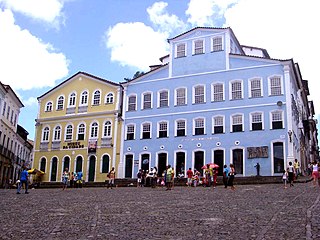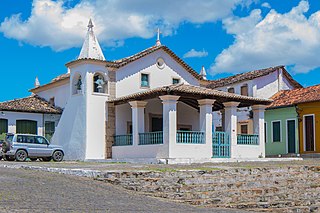
Bahia is one of the 26 states of Brazil and is located in the northeastern part of the country on the Atlantic coast. It is the 4th-largest Brazilian state by population and the 5th-largest by area. Bahia's capital is the city of Salvador, located on a spit of land separating the Bay of All Saints from the Atlantic. Once a monarchial stronghold dominated by agricultural, slaving, and ranching interests, Bahia is now a major manufacturing center whose last three elections have been dominated by the Workers' Party.

Daniela Mercury is a Brazilian singer, songwriter, dancer, producer, actress and television host. In her solo career, Mercury has sold over 20 million records worldwide and had 24 Top 10 singles in the country, with 14 of them reached #1. Winner of a Latin Grammy for her album Balé Mulato – Ao Vivo, she also received six Brazilian Music Award, an APCA award, three Multishow Brazilian Music Awards and two awards at VMB: Best Music Video and Photography.
Zélia Gattai Amado de Faria was a Brazilian photographer, memoirist, novelist and author of children's literature, as well as a member of the Brazilian Academy of Letters. Gattai has written 14 different literary works, including children's books and her own personal memoirs that have been widely published.
The Malê revolt is perhaps the most significant slave rebellion in Brazil. On a Sunday during Ramadan in January 1835, in the city of Salvador da Bahia, a small group of black slaves and freedmen, inspired by Muslim teachers, rose up against the government. Muslims were called malê in Bahia at this time, from Yoruba imale that designated a Yoruba Muslim.

Brazil–Nigeria relations refers to the current and historical relationship between Brazil and Nigeria. Relations focus primarily upon trade and culture. The two nations, one the largest country in Latin America by size, the other the largest country in Africa by population, are remotely bordered across from one another by the Atlantic Ocean. For centuries, Brazil and Nigeria have enjoyed a warmly friendly and strong relationship on the bases of culture and commercial trade. Nigeria is a major provider of petroleum to Brazil.

Barra is a neighborhood located in the south zone of the city of Salvador, Bahia, Brazil. Barra is one of the most traditional neighborhoods of the city, and is also one of the most popular neighborhoods for tourists, with many attractions, like Farol da Barra Lighthouse, Morro do Cristo Hill, Farol da Barra Beach, and Porto da Barra Beach.

The Historic Center (US) or Centre of Salvador de Bahia in Brazil, also known as the Pelourinho or Pelo, is a historic neighborhood in western Salvador, Bahia. It was the city's center during the Portuguese colonial period and was named for the whipping post in its central plaza where African slaves received punishment for various infractions, as well as for disciplinary purposes. The Historic Center is extremely rich in historical monuments dating from the 17th through the 19th centuries.
Liberdade is the second most populous district of Salvador,. Salvador is the Capital City of the Brazilian State of Bahia.
LAB – Linhas Aéreas Brasileiras S.A. was a Brazilian airline founded in 1945. It ceased operations in 1948.
Viação Aérea Bahiana was a Brazilian airline founded in 1945. It ceased operations on November 4, 1948.
Brazilians in Nigeria consist mostly of descendants of freed Afro-Brazilian slaves who left Brazil and settled in Nigeria as well as expatriates from Brazil.
The following is a timeline of the history of the city of Salvador, Bahia state, Brazil.

Comércio is a neighborhood of Salvador, Bahia, Brazil. The district served as the port of entry to Salvador from the beginning of the colonial period and later became home to the first planned business district in Brazil. It remains a financial center in the state of Bahia, as well as a municipal transportation hub and tourist destination. Comércio is home to numerous national heritage sites dating from the early colonial period to the 20th century. Comércio as a whole was listed as a national historic district of Brazil by the National Institute of Historic and Artistic Heritage in 2008.

The Chapel of Our Lady of Help is a 17th-century Roman Catholic church located in Cachoeira, Bahia, Brazil. It is the first church built in Cachoiera as part of the Adorno family sugar plantation and is home to the Brotherhood of Our Lady of Help. The chapel attracts a large number of pilgrims devoted to Our Lady of Help. The chapel was listed as a historic structure by National Institute of Historic and Artistic Heritage (IPHAN) in 1939.

The Church of the Third Order of Mount Carmel is an 18th-century Roman Catholic church in Salvador, Bahia, Brazil. It is located adjacent to the Church and Convent of Our Lady of Mount Carmel. The Church of the Third Order of Mount Carmel was listed as a historic structure by National Institute of Historic and Artistic Heritage (IPHAN) in 1938 and is part of the Historic Center of Salvador UNESCO World Heritage Site.

The Church of the Third Order of Our Lady of the Rosary of the Black People (Portuguese: Igreja da Ordem Terceira de Nossa Senhora do Rosário dos Pretos is an 18th-century Roman Catholic church in Salvador, Bahia, Brazil. The church was listed as a historic structure by National Institute of Historic and Artistic Heritage in 1938 and is part of the Historic Center of Salvador UNESCO World Heritage Site.

The Lacerda Elevator(Elevador Lacerda) is a public urban elevator located in Salvador, Brazil, connecting the lower city (Cidade Baixa) to the upper city (Cidade Alta). The 72 metres (236 ft) elevator was built between 1869 and 1873; it was named after Antônio de Lacerda, director of the Commercial Association of Bahia. It was a hydraulic elevator at first; later operating by electricity since 1906. The elevator towers were renovated in 1930, in an Art Deco styling. The Lacerda Elevator has two towers and four lifts, carrying 27 passengers each on a 30-second ride costing 0.15 reais. It transports 15 thousand people/day.

The Church and Convent of Our Lady of Solitude is an 18th-century Roman Catholic church and former convent in Salvador, Bahia, Brazil. The church and convent were founded in 1736 and are dedicated to Our Lady of Solitude. The convent has functioned as a school since 1927. The Church and Convent of Our Lady of Solitude is located within the Protected Historic District of Soledade by the State of Bahia.
















